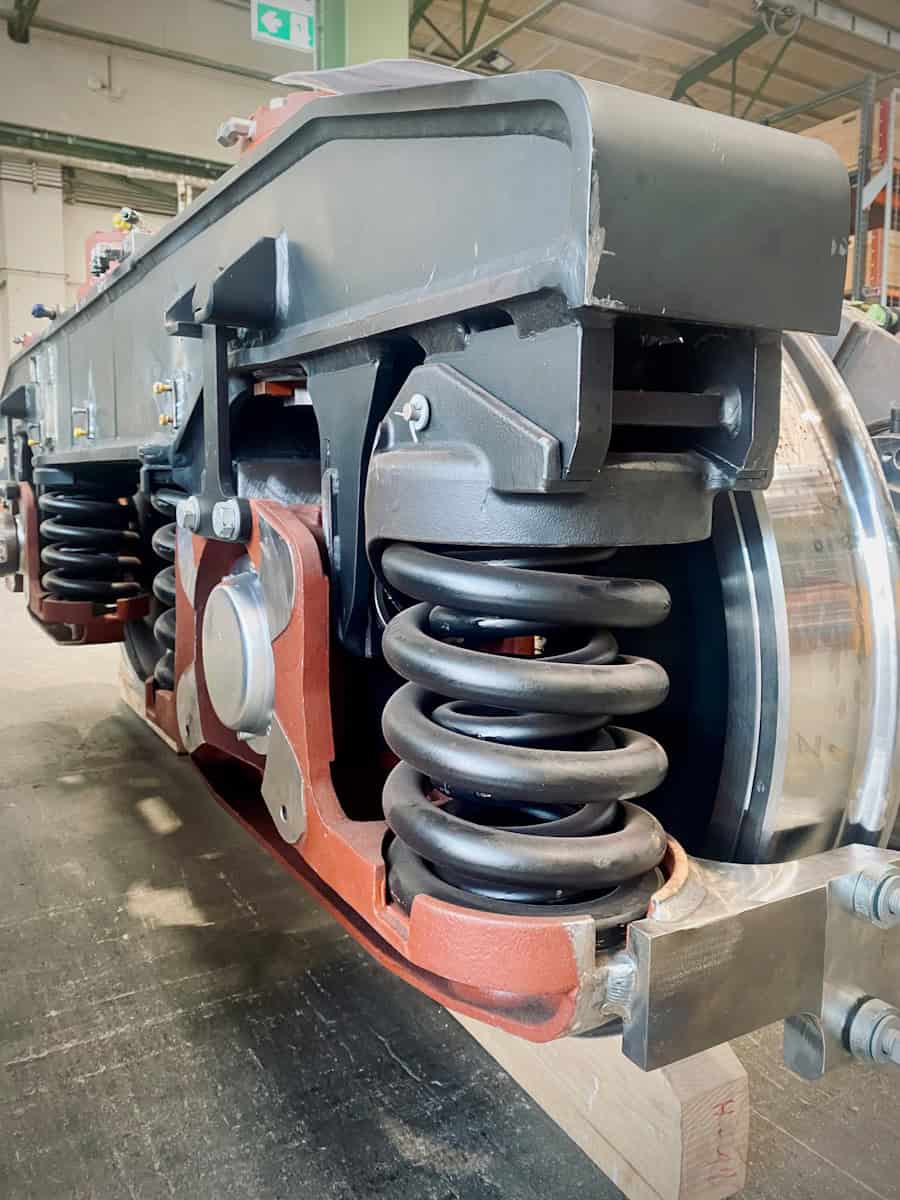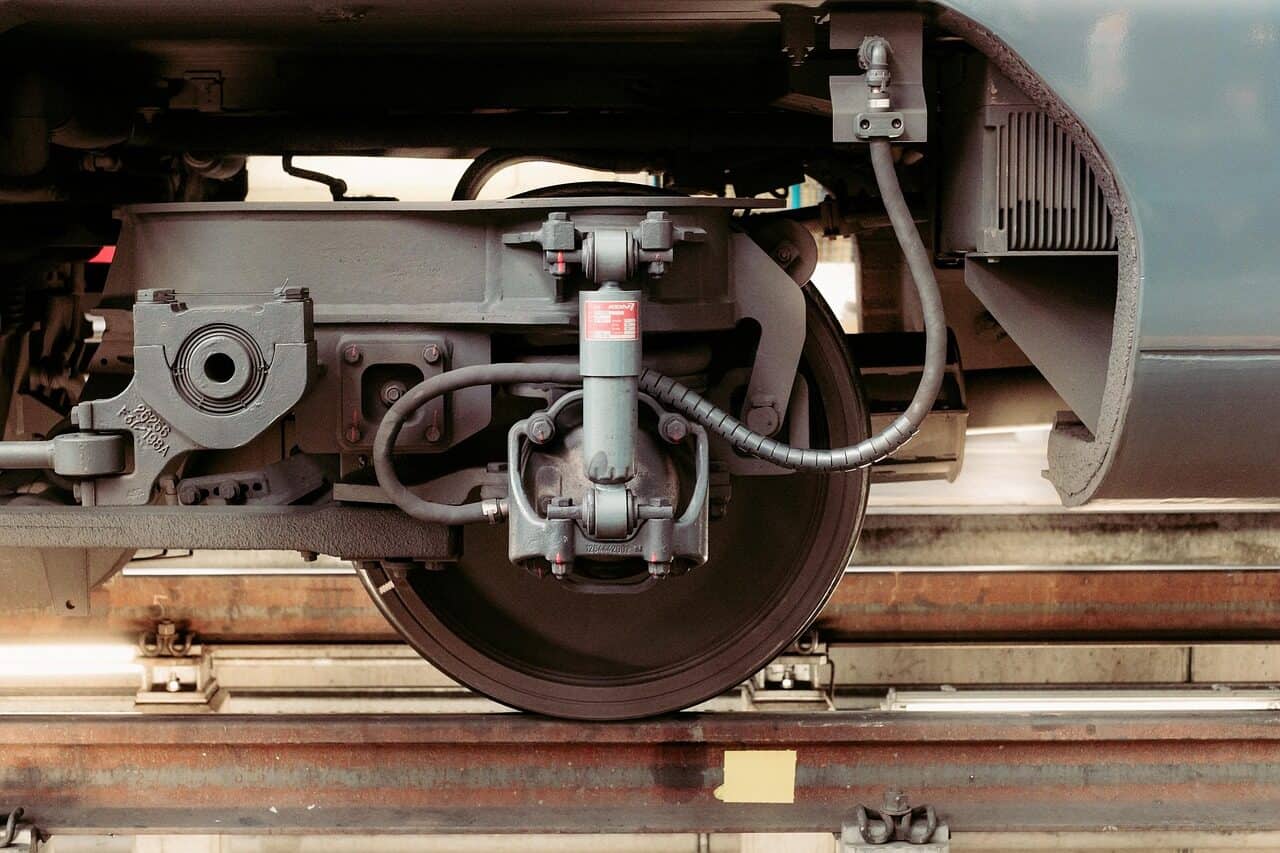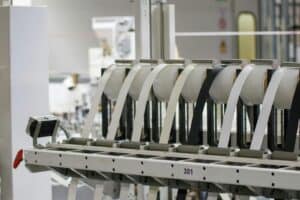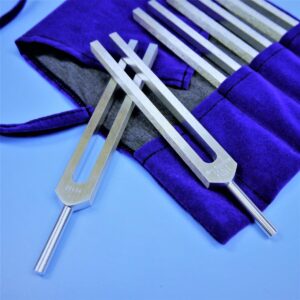エンジニアのためのトラック・メンテナンス・ガイド:基本を理解する
鉄道線路を良好な状態に保つことは、国の経済と公共の安全にとって不可欠である。一見単純なルーティンワークのように見えるが、効果的な線路保守は実は複雑な工学分野である。列車の車輪とレールが接触する部分に生じる大きな力を処理するために、材料科学、土壌工学、機械工学の知識を駆使します。このガイドでは、単に作業を列挙するだけでなく、線路を健全に保つための工学と物理学の原理を明確に理解できるようにする。線路を動くシステムとしてとらえ、損傷を引き起こす力を研究し、なぜ特定の修理が必要なのかを説明し、メンテナンス戦略が時代とともにどのように変化してきたかを探ります。
この分析はあなたの理解を助けるだろう:
- エンジニアリングの観点から見た各トラックパーツの役割。
- 線路が壊れる基本的な物理学的、材料科学的理由。
- タンピング、グラインディング、バラストの清掃など、主要なメンテナンス手順が必要な理由。
- 予防的なものから予測的なものまで、さまざまな最新のメンテナンスアプローチを比較。
- 線路保守の未来を変える新技術。
エンジニアード・ファンデーション
メンテナンスを理解するには、まず線路を単純な道としてではなく、エネルギーを管理し分散させるために注意深く設計された複雑な工学システムとしてとらえる必要がある。各パーツは、列車からの巨大な移動荷重を吸収し、安全に地面に伝えるという特定の仕事を持っている。各パーツがなぜそのように設計されているのかを理解することは、それがどのように故障するのか、なぜ私たちがそのようにメンテナンスするのかを理解するのに役立つ。
レール・エレメント
レールは主に2つの仕事をする。車輪フランジを使って列車の車輪をガイドすることと、列車の往来による上下、左右、前後の大きな力を支えることだ。レールの形状は、車輪とレールの接触面積を最適化するように設計されている。これにより、応力と摩耗が軽減される。素材そのものは、先進的な金属製造から生まれたものだ。最新のレールは通常、欧州(EN 13674)または同様のAREMA規格に基づくR260やR350HTグレードなどの高炭素耐摩耗鋼で作られている。これらの金属混合物は、繰り返される応力サイクルに耐えるように設計されており、数百万回の荷重サイクルに対応できるよう、880MPaを超える引張強度を持つことが多い。
スリーパー・システム
マクラギ(タイ)は、線路の軌間(レール間の距離)を堅固に保ち、レールの足から集中する荷重をバラストの広い範囲に分散させるという、2つの重要な役割を果たす横方向の部品である。この荷重分散は土質工学の基本原理であり、バラストにかかる圧力を減らして、バラストが押しつぶされたり脇に押しやられたりするのを防ぎます。まくらぎの材料を選択するには、工学的なトレードオフが伴います。プレストレスト・コンクリートは、圧縮時の強度に優れ、耐用年数が長く、重量が大きいため、軌道全体の安定に役立ちます。広葉樹は、寿命は短いものの、優れた柔軟性と自然な振動減衰を提供する。スチール製や複合製の枕木は、手の届きにくい場所での軽量性や、虫害などの環境要因への耐性が評価され、特定の状況で使用されます。
ファスナーシステム
締結システムは、レールをまくらぎに固定する重要なリンクです。その役割は、単純な取り付けにとどまりません。温度膨張やブレーキ・加速力によって生じるレールのクリープと呼ばれる長さ方向のレールの動きに対抗するため、安定したクランプ力を提供する必要があります。また、線路が遮断されている場所では、レールを互いに、また地面から分離するための電気絶縁も行わなければなりません。Pandrol e-ClipやVosslohシステムのような最新の弾性締結システムは、特定の設計されたつま先荷重を提供するように設計されています。その柔軟性は非常に重要で、クランプ強度を失うことなく、荷重下でレールの垂直方向の微小な動きを可能にし、それによって振動を吸収し、枕木やバラストへの衝撃伝達を低減します。
バラストと下地
バラスト層とその下の下層は、軌道の柔軟な基礎を形成する。バラストは、砕かれた硬い角ばった石の層で、いくつかの工学的機能を同時に果たします。バラストは、軌道の形状を正確に修正するための媒体となり、軌道構造から水を速やかに排水するのに役立ち、粒子間の摩擦によって左右、上下、長さ方向の力に抵抗します。石の角張った形状は、この摩擦抵抗をもたらすインターロックの形成に極めて重要である。空隙率、つまり石と石の間の空隙の量は、排水にとって重要である。バラストの深さは、枕木からの圧力を、地盤(原生土または準備された基礎層)が永久的な屈曲や基礎の破損なしに支えることができるレベルまで分散させるために計算されます。
劣化の科学
トラックは単純に "消耗 "するわけではない。予測可能な、相互作用する一連の物理的プロセスによって悪化するのだ。これらのメカニズムを材料科学や物理学のレベルで理解することは、問題が起こってから直すのではなく、問題が起こる前に防ぐために不可欠です。劣化は、繰り返される負荷、環境への暴露、材料の反応によって生じます。
機械的摩耗メカニズム
最も明らかな劣化は、車輪とレールが接触する部分の機械的摩耗である。これは主に2つの方法で起こる。粘着摩耗はミクロのレベルで起こるもので、接触部に大きな圧力がかかることで小さな溶接部が形成され、車輪が転がるとすぐに破断して小さな破片が引き剥がされる。磨耗は、車輪とレールの間に挟まった硬い粒子(砂や車輪のフランジ材など)によって引き起こされる擦過作用である。
より隠れたメカニズムは、転がり接触疲労(RCF)である。1,500MPaを超えることもある、通過する各ホイールからの繰り返し接触応力は、スチールに疲労を引き起こす。これはペーパークリップを折れるまで前後に曲げるようなものである。この過程で、通常は表面直下でマイクロクラックが発生し、それが成長していく。これらの亀裂が表面に達すると、ヘッドチェック(ゲージ角の微細な亀裂)、スクワット(走行面の凹み)、シェリング(大きな金属片の破断)などの重大な欠陥として現れます。例えば、30トンの車軸荷重を持つ重荷重貨物路線では、数億総トンがきついカーブを通過した後、高い応力が必然的に高レールの軌間角にRCF微細クラックを発生させる。管理されなければ、これらは成長し、結合し、壊滅的なレールの破損につながる。
変形とジオメトリー
軌道形状の劣化とは、軌道が意図した垂直および水平の形状を失うことである。これは、バラスト基礎への動的な繰り返し荷重の直接的な結果です。車軸が通過するたびに力が加わり、バラスト石に小さな沈下と再配列が生じます。時間が経つにつれて、こうした小さな動きが積み重なり、不均等な支持につながります。その結果、アライメント(軌道の直線性)、レベルまたはトップ(垂直プロファイル)、カントまたはスーパーエレベーション(カーブでのバンク)に測定可能な偏差が生じる。
レール自体も変形することがある。大きな荷重がかかると、レール頭部の金属がゆっくりと押されて平らになり、走行帯が広がる塑性流動が発生することがある。レールの波形は、走行面の波のような模様で、車輪とレールが特定の周波数で共振する「スティック・スリップ」相互作用から生じる複雑な動的現象であり、偏摩耗、騒音の増加、高衝撃荷重につながる。
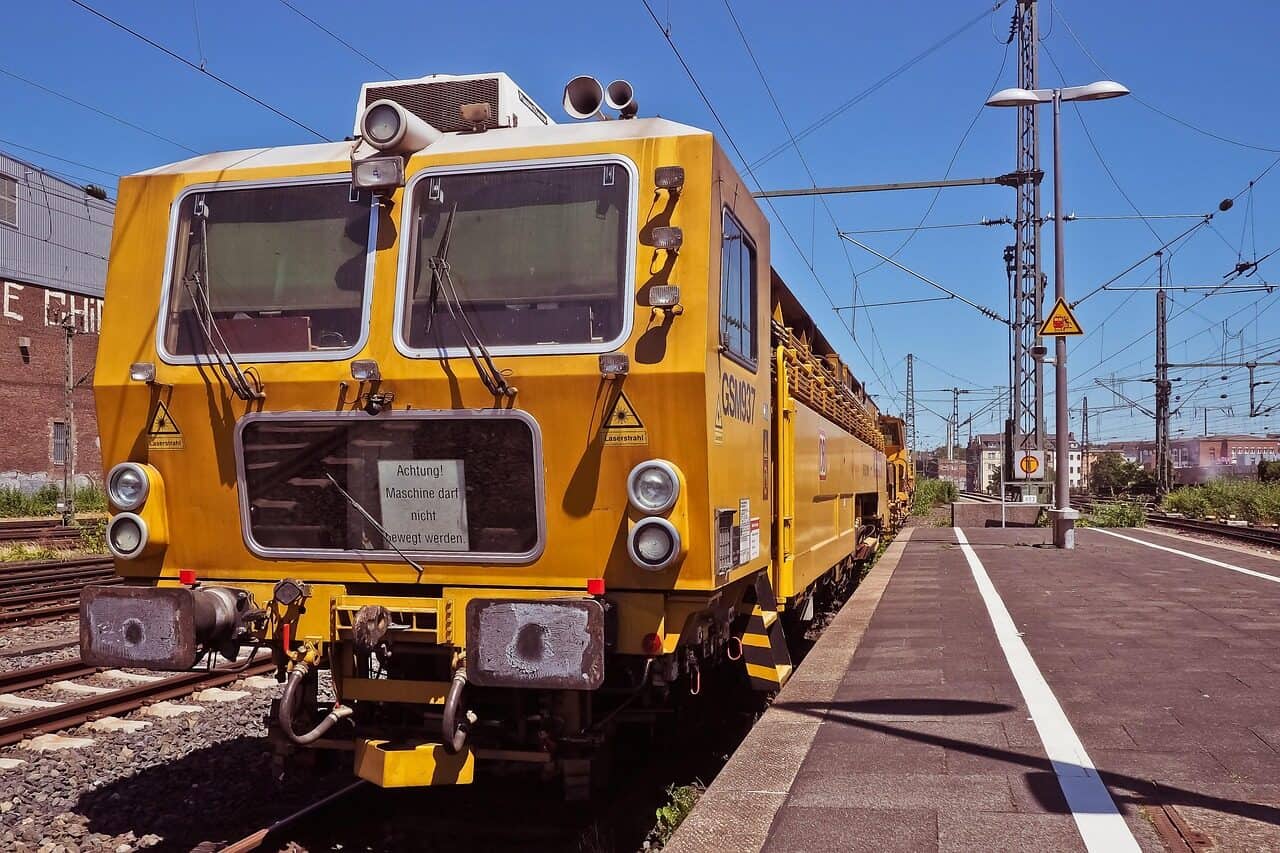
素材と環境
軌道の基礎そのものが劣化の対象になる。バラストの汚損は、角張った石の間が細かい粒子で詰まるプロセスです。これらの微粒子は、バラスト石自体の破壊と粉砕(摩耗)、通過する列車からの石炭や鉄鉱石の粉塵、湿った不安定な下地からの土壌の「汲み上げ」など、いくつかの原因から発生します。空間が埋まると、バラストは水を排出する能力を失います。この閉じ込められた水が石を潤滑し、粒子間の摩擦を減らして、ジオメトリーの劣化を劇的に早めます。汚染されたバラストベッドは、柔軟で自由排水性のある層というよりも、固体の塊のような挙動を示します。腐食はもうひとつの重要な要因であり、特に沿岸地域やトンネルのような湿度の高い、汚染された、塩分の多い環境では、化学的プロセスによって鋼鉄レールや締結部品が侵されます。
表1:一般的なトラックの欠陥とその技術的原因
| 欠陥名 | 技術説明 | 第一次因果律 |
| ヘッドチェック | レールヘッドのゲージ・コーナーに平行に連なる細かい亀裂。 | 車輪とレールの高サイクル接触応力による転がり疲労(RCF)。 |
| バラストの汚損 | バラストの空隙に微粒子(砕石、石炭粉、土など)が詰まること。 | 粒子摩耗、下層ポンピング、粒子間摩擦の損失。 |
| トラック・バックリング | トラックパネルの横方向の蛇のような変位。 | 連続溶接レール(CWR)における圧縮熱応力の未管理。 |
| スクワット | レール走行面の局所的なくぼみで、しばしば亀裂を伴う。 | 高衝撃の動的負荷とRCFの開始。 |
| ミスアライメント | 線路の水平方向の真直度や曲率の偏差。 | 沈下によるバラストと枕木からの不均一な横方向の支持。 |
介入の原則
軌道のメンテナンス作業は無作為に行われるものではなく、先に詳述した劣化メカニズムに対抗するために設計された、特定の工学的介入である。それぞれの作業には、ジオメトリーの復元、材料の再調整、応力の管理など、明確な技術的目標があります。各作業の背後にある工学原理を理解することが、その適切な適用と有効性の鍵となる。
トラック・ジオメトリーの復元
タンピングとストーン・ブローが、軌道形状の欠陥を修正する主な方法である。
- Tamping: This is the most common method for restoring correct vertical and horizontal track geometry. A tamping machine uses vibrating tines that are inserted into the ballast on either side of a sleeper. The vibration temporarily makes the ballast flow like liquid, allowing the tines to squeeze together and pack stone directly under the sleeper base. This process lifts the track to a precise, pre-calculated position, correcting errors in level and alignment and re-establishing a uniform, compacted load-bearing surface beneath the sleeper.
- Stoneblowing: This is a more precise, less disruptive alternative to tamping. Instead of packing existing ballast, a stoneblowing machine uses high-pressure air to inject a measured quantity of new, smaller-sized stone into the spaces directly beneath the sleeper. This provides a very accurate lift and creates a durable stone “shim.” The primary technical advantage is that it does not disturb the existing, well-compacted ballast structure, often resulting in a longer-lasting geometry correction.
Managing the Interface
Rail grinding is a critical machining process that manages the condition of the wheel-rail interface itself. It is both a corrective and a preventive measure. The primary technical goals are:
- Removing RCF: Grinding removes the surface layer of the rail head, eliminating beginning head checks and other RCF-related micro-cracks before they can grow deeper into the rail and become major defects requiring rail replacement.
- Profile Correction: Grinding is used to reshape the rail head to a specific, engineered target profile. This target profile is designed to match the worn wheel profiles of the traffic using the line, optimizing the contact area to ensure proper vehicle steering on curves and reduce contact stresses. This proactive profile management is a cornerstone of modern maintenance, significantly reducing the rate of both rail and wheel wear.
- Corrugation Removal: The process effectively mills away the peaks of rail corrugations, restoring a smooth running surface and eliminating the high-frequency, high-impact dynamic loads that cause noise, vibration, and accelerated degradation of other track components.
Reconditioning the Foundation
When the ballast foundation itself has degraded, its primary functions must be restored through ballast cleaning or renewal.
- Ballast Cleaning: The principle behind this intervention is to restore the ballast’s drainage capacity and flexibility by removing the fine particles that cause fouling. A large on-track machine excavates the ballast from the shoulder and from beneath the sleepers. The excavated material is passed over a series of vibrating screens that separate the good, correctly sized ballast stone from the dirt, dust, and broken fragments. The cleaned stone is then put back into the track, and new stone is added to compensate for the removed material and to restore the correct ballast profile. This re-establishes the void ratio necessary for drainage and restores the friction between particles required for track stability.
Table 2: Maintenance Intervention vs. Technical Objective
| Maintenance Intervention | Primary Technical Objective | Degradation Counteracted |
| Tamping | Restore correct track geometry (level, alignment). | Differential ballast settlement, loss of uniform support. |
| Rail Grinding | Correct rail head profile and remove surface defects. | Rolling Contact Fatigue (RCF), plastic flow, corrugation. |
| Ballast Cleaning | Restore ballast drainage and elasticity. | Ballast fouling, particle breakdown, reduced friction. |
| Welding (Thermit/Flash-Butt) | Repair broken rails or create Continuously Welded Rail (CWR). | Rail fractures, joint-related impact loads. |
| Destressing | Re-establish the correct neutral temperature in CWR. | Risk of track buckling (compression) or pull-aparts (tension). |
The Evolution of Strategy
The philosophy guiding when and where to perform maintenance has evolved significantly, driven by technology, data analytics, and a deeper understanding of risk. The goal has shifted from simply fixing failures to proactively managing the rate of degradation, optimizing both safety and cost.
Reactive Maintenance
The “find and fix” model is the most basic strategy. Intervention occurs only after a component has failed or a defect has been identified that exceeds safety limits, often during a routine visual inspection or following an operational incident. This approach is characterized by its reliance on manual inspection and basic repair techniques. While it has the lowest upfront planning cost, it carries the highest long-term cost due to the high expense of emergency repairs, operational disruptions, and the significant risk of catastrophic failure. It is an inherently inefficient and high-risk way to manage a complex asset.
Preventive Maintenance
Preventive, or time-based, maintenance represents a significant strategic improvement. Interventions are scheduled at pre-determined intervals, which can be based on time (e.g., tamping every two years) or usage (e.g., grinding after every 50 million gross tonnes of traffic). These schedules are derived from statistical analysis of historical failure data, using methods like Weibull analysis to determine a component’s average service life or Mean Time Between Failures (MTBF). This strategy requires robust data logging of asset history and traffic, along with structured planning systems. It reduces the likelihood of in-service failures but can be inefficient, sometimes replacing components that still have significant remaining useful life or, conversely, failing to prevent a premature failure.
Predictive Maintenance
Predictive, or condition-based, maintenance is the current state-of-the-art. It embodies the principle of “maintain only when necessary.” Intervention is not driven by a fixed schedule but is triggered when frequently collected data indicates that a component’s condition is degrading towards a pre-defined performance or safety threshold. This data-driven approach relies heavily on advanced technology. Automated inspection vehicles, such as track geometry cars and ultrasonic test units, collect vast amounts of data on track condition. Wayside sensor systems detect real-time impacts from defective wheels or bearings. The core of this strategy lies in data analysis, where algorithms and machine learning models analyze trends to predict the future state of the track. For example, an algorithm might trigger a tamping intervention not when geometry reaches a limit, but when the rate of change of the standard deviation in track top level accelerates, indicating that the ballast is losing its stability and will soon require intervention.
Table 3: Technical Comparison of Maintenance Philosophies
| 特徴 | Reactive Maintenance | Preventive Maintenance | Predictive Maintenance |
| Trigger for Action | Component failure or observed defect. | Fixed schedule (time or usage). | Condition data exceeds a set threshold. |
| Primary Data Source | Visual inspection, failure reports. | Historical failure statistics, usage logs. | Real-time sensor data, trend analysis. |
| Underlying Model | None (act on failure). | Statistical (e.g., Mean Time Between Failures). | Algorithmic (e.g., regression, machine learning). |
| Key Technology | Basic hand tools, visual aids. | Planning software, data logging systems. | Automated inspection vehicles, IoT sensors, AI platforms. |
| Optimization Goal | Restore function. | Maximize average component lifespan. | Maximize actual component life, minimize risk. |
Conclusion: A Data-Driven Discipline
Modern track maintenance has moved beyond its historical image of manual labor. It is a sophisticated, data-driven engineering discipline. Understanding the track as a dynamic system, governed by the laws of physics and materials science, is the foundation for any effective maintenance program. The degradation of this system is not random but follows predictable patterns of wear, fatigue, and deformation that can be measured, modeled, and managed.
The interventions we apply—from grinding to tamping to ballast cleaning—are precise engineering solutions designed to counteract these specific scientific principles of decay. By moving beyond a reactive or purely time-based approach, the industry is embracing a data-driven strategy. Predictive maintenance, enabled by advanced sensors and artificial intelligence, allows for the optimization of every intervention, maximizing asset life while minimizing both cost and risk. This principles-based approach, combining deep engineering knowledge with powerful data analytics, is what ensures the continued development of safer, more reliable, and more economically viable railway networks for the future.
- https://arema.org/ American Railway Engineering and Maintenance-of-Way Association
- https://www.uic.org/ 国際鉄道連合(UIC)
- https://en.wikipedia.org/wiki/Track_ballast Wikipedia – Track Ballast
- https://railroads.dot.gov/ 連邦鉄道管理局(FRA)
- https://www.transit.dot.gov/ Federal Transit Administration – Track Maintenance Standards
- https://www.sciencedirect.com/ ScienceDirect – Railway Ballast and Maintenance Research
- https://www.researchgate.net/ ResearchGate – Railway Track Maintenance Research
- https://www.loram.com/ Loram Maintenance of Way – Rail Grinding Technology
- https://www.bnsf.com/ BNSF Railway – Track Maintenance Guidelines
- https://www.up.com/ Union Pacific – Railway Engineering and Maintenance

